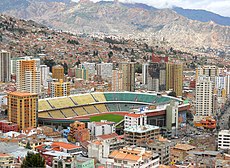Culture of Bolivia
| Part of a series on the |
| Culture of Bolivia |
|---|
 |
| History |
|
People |
Bolivia is a country in South America, bordered by Brazil to the north and east, Paraguay and Argentina to the south, Chile to the west, and Peru to the west.
The cultural development of what is now Bolivia is divided into three distinct periods: pre-Columbian, colonial, and republican. Important archaeological ruins, gold and silver ornaments, stone monuments, ceramics, and weavings remain from several important pre-Columbian cultures. Major ruins include Tiwanaku, Samaipata, Inkallaqta and Iskanwaya. The country abounds in other sites that are difficult to reach and hardly explored by archaeologists.
The Spanish brought their own tradition of religious art which, in the hands of local indigenous and mestizo builders and artisans, developed into a rich and distinctive style of architecture, literature, and sculpture known as "Mestizo Baroque." The colonial period produced not only the paintings of Perez de Holguin, Flores, Bitti, and others, but also the works of skilled but unknown stonecutters, woodcarvers, goldsmiths, and silversmiths. An important body of native baroque religious music of the colonial period was recovered in recent years and has been performed internationally to wide acclaim since 1994. Bolivian artists of stature in the 20th century include, among others, Guzman de Rojas, Arturo Borda, María Luisa Pacheco, Master William Vega, Alfredo Da Silva, and Marina Núñez del Prado.
Festivals
Dances
Many dances and songs contain elements from both the native and European cultures. Caporales seems to be the most popular Bolivian dance of present times – in a few decades it has developed into an enormously popular dance, not only in the Highlands where it originated, but also in the Lowlands and in Bolivian communities outside the country. In the Highlands, other traditional and still very popular dances are:
- Awki awki
- Cambitas
- Ch'utas
- Diablada
- Kullawada
- Llamerada
- Morenada
- Pukllay
- Afro-BolivianSaya
- Siklla (Wayra, Doctorcitos)
- Suri Sikuri
- Tango
- Tinku
- Tobas
- Waka Waka
In the Lowlands, there are:
- Macheteros
- Taquirari
- Chovena
Clothing
Clothing of Andean people of indigenous descent includes the pollera (pleated-skirt), the 19th century European bowler hat, and a silky shawl known as a manta.[1] The pollera was originally a simple Spanish dress that colonial authorities forced the indigenous populations to wear. The pollera is a symbol of pride for the indigenous people, who live in La Paz, and for people in rural areas.
The inhabitants of Santa Cruz de la Sierra, from babies to seniors, wear the same kind of clothes that are typical in western countries, like jeans, shorts (which are the most common because of the heat), t-shirts, dresses, etc.
Sports
The
La Paz has the highest tournament-class golf course in the world.
Stadiums in Bolivia

For football stadiums in Bolivia, see List of football stadiums in Bolivia. Indoor stadiums in Bolivia can be found in the table below.
| Rank | Venue | Date built | Capacity | City | Image |
|---|---|---|---|---|---|
| 1 | Polideportivo Evo Morales | 2015 | 12,000 | Quillacollo | |
| 2 | Coliseo Julio Borelli Viterito | 1977 | 10,000 | La Paz | |
| 3 | Polideportivo Garcilazo | 2009 | 10,000 | Sucre | |
| 4 | Polideportivo Héroes de Octubre | 2013 | 10,000 | El Alto | |
| 5 | Coliseo Eduardo Leclere Polo | 2000 | 10,000 | Oruro |
Cuisine
Music

Bolivia's regional folk music is distinctive and varied. In the Andean regions, music is played during the festivals and dances. Some tunes contain strong Spanish influences.
The most common musical instruments are:
- Sicu (also sicus)
- tharqa
- Pinkillo
- Skin drums
- Copper bells
- Wood
- Guitar
- Flute
- Zampoña
- Matraca
- Mandolina
- Charango
- Quena
See also
- Architecture of Bolivia
- Andean culture
- Hispanic culture
- Latin American culture
- NGO
- Lists of stadiums
References
This article needs additional citations for verification. (September 2014) |
- ^ Forero, Juan. "Women leave traditional Bolivian dress in closet". The New York Times. Retrieved April 5, 2013.

